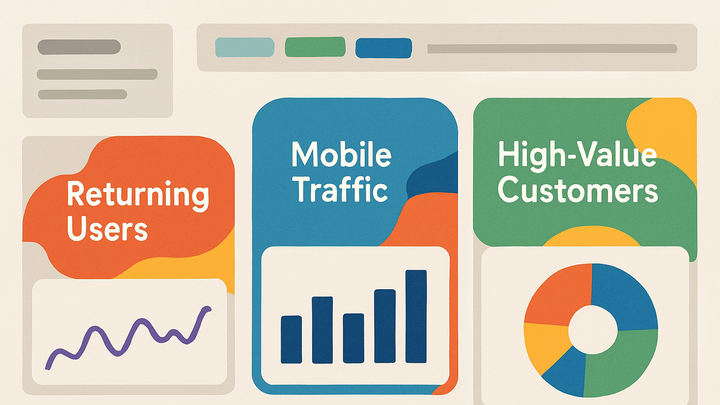Published on 2025-06-27T18:57:32Z
What Are Segments in Analytics? Examples and Use Cases
Segments are subsets of analytics data that allow teams to isolate specific user behaviors, characteristics, or session attributes for more precise analysis. In platforms like Google Analytics 4 (GA4) and PlainSignal, segments enable you to filter reports to focus on groups such as new versus returning users, high-value customers, or traffic from a particular campaign. By breaking overall metrics into meaningful cohorts, you can uncover hidden trends, diagnose issues in the user journey, and personalize experiences. GA4 uses an event-based model to define segments based on user or session conditions, while PlainSignal offers a cookieless, privacy-conscious approach with an intuitive dashboard for quick segment creation. Properly leveraging segments reduces data noise, improves decision-making, and drives targeted growth strategies. Armed with well-crafted segments, analysts and marketers can answer nuanced questions such as Which traffic sources yield the longest sessions? or How first-time purchasers interact compared to repeat buyers?
Segments
Subsets of user or session data filtered by criteria, enabling targeted analysis in GA4 and PlainSignal.
Importance of Segments
Segments help you focus on the most relevant slice of your data, reducing noise and enabling deeper insights.
-
Targeted analysis
Focus on specific user groups to reduce noise and uncover actionable insights.
-
Personalization
Drive personalized content and campaigns based on segment insights.
Common Types of Segments
Segments can be based on user attributes, session characteristics, or specific events. Each type offers a different lens on user behavior.
-
User-based segments
Group users by properties such as demographics, location, or lifetime value.
-
Demographic
Segments based on age, gender, and geographic location.
-
Behavioral
Segments based on actions like purchase history or session frequency.
-
-
Session-based segments
Filter sessions by attributes like traffic source or duration.
-
Traffic source
Organic, paid, social, or direct session groupings.
-
Session duration
Short (<1 min), medium (1–5 min), or long (>5 min) sessions.
-
-
Event-based segments
Segment by interactions like button clicks, video plays, or custom events.
-
Custom events
Define segments around developer-instrumented events, e.g., form submissions.
-
Creating Segments in GA4
GA4’s interface lets you build segments with flexible conditions on users, sessions, or events.
-
Segment builder
Use the Explore workspace to define and test segments before applying them.
-
Navigate to exploration
Go to Explore > Blank and open the Segments pane.
-
Define conditions
Add filters for demographics, events, or session metrics.
-
Apply segment to report
Drag your segment into the report to compare against the total user base.
-
-
Example segment: engaged users
Define engaged users as sessions with more than 2 pageviews and duration over 60 seconds.
Defining Segments in PlainSignal
PlainSignal is a cookieless, privacy-first analytics tool. After adding the tracking snippet, you can build segments in minutes using its dashboard.
-
Installation
Add the tracking snippet to your HTML to start collecting data.
-
Tracking snippet
<link rel="preconnect" href="//eu.plainsignal.com/" crossorigin /> <script defer data-do="yourwebsitedomain.com" data-id="0GQV1xmtzQQ" data-api="//eu.plainsignal.com" src="//cdn.plainsignal.com/plainsignal-min.js"></script>
-
-
Segment setup in dashboard
In the PlainSignal dashboard, define segments with simple rules, e.g., pageviews > 2 or utm_source equals newsletter.
Best Practices for Segment Analysis
Adopt these guidelines to ensure your segments yield reliable, actionable insights.
-
Statistical significance
Ensure segments have enough sample size to yield reliable insights.
-
Naming and organization
Use clear, consistent names and group similar segments for easy navigation.
-
Continuous review
Regularly revisit and adjust segment definitions to reflect changing user behavior.
